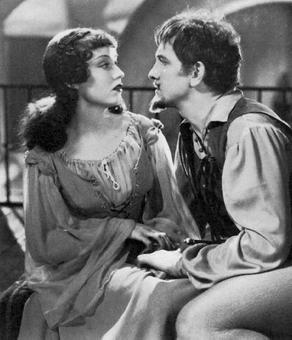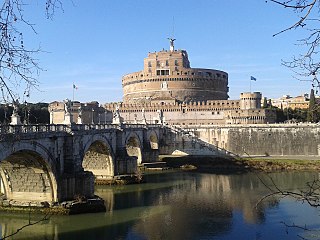Related Research Articles

The Affairs of Cellini is a 1934 comedy film directed by Gregory La Cava and starring Frank Morgan, Constance Bennett, Fredric March, Fay Wray, and Louis Calhern. It is set in Florence. The film was adapted by Bess Meredyth from the play The Firebrand of Florence by Edwin Justus Mayer.

Benvenuto Cellini was an Italian goldsmith, sculptor, and author. His best-known extant works include the Cellini Salt Cellar, the sculpture of Perseus with the Head of Medusa, and his autobiography, which has been described as "one of the most important documents of the 16th century".

The Mausoleum of Hadrian, usually known as Castel Sant'Angelo, is a towering cylindrical building in Parco Adriano, Rome, Italy. It was initially commissioned by the Roman Emperor Hadrian as a mausoleum for himself and his family. The building was later used by the popes as a fortress and castle, and is now a museum. The structure was once the tallest building in Rome.

Benvenuto Cellini is an opera semiseria in four tableaux by Hector Berlioz, his first full-length work for the stage. Premiered at the Académie Royale de Musique on 10 September 1838, it is a setting of a libretto by Léon de Wailly and Henri Auguste Barbier who were inspired by the memoirs of the titular Florentine sculptor but who invented most of the plot. The opera is technically challenging and was until the 21st century rarely performed. But its overture sometimes features in orchestral concerts, as does the concert overture Le carnaval romain which Berlioz composed from material in the opera.

The Loggia dei Lanzi, also called the Loggia della Signoria, is a building on a corner of the Piazza della Signoria in Florence, Italy, adjoining the Uffizi Gallery. It consists of wide arches open to the street. The arches rest on clustered pilasters with Corinthian capitals. The wide arches appealed so much to the Florentines that Michelangelo proposed that they should be continued all around the Piazza della Signoria.

The Cellini Salt Cellar is a part-enamelled gold table sculpture by Benvenuto Cellini (c.1500-1571). It was completed in 1543 for Francis I of France (r.1515-1547), from silver plate models that had been prepared many years earlier for Cardinal Ippolito d'Este (c.1479-1520).
The Rospigliosi Cup, sometimes referred to as the Cellini Cup, is a decorative ornament in gold and enamel, previously attributed to Benvenuto Cellini (1500–1571), but now known to be an art forgery, of nineteenth-century manufacture.
Cellini is a 2001 play by American playwright John Patrick Shanley. It is based on the process that the sculptor Benvenuto Cellini went through in order to create his mid-16th century work Perseus with the Head of Medusa.
The harpē (ἅρπη) was a type of sword or sickle; a sword with a sickle protrusion along one edge near the tip of the blade. The harpe is mentioned in Greek and Roman sources, and almost always in mythological contexts.

French composer Hector Berlioz wrote a number of "overtures", many of which have become popular concert works. They include true overtures, intended to introduce operas, but also independent concert overtures that are in effect the first orchestral tone poems.
Events from the year 1558 in art.
Benvenuto may refer to:
Benvenuto Cellini (1500–1571) was an Italian goldsmith, painter, sculptor, soldier and musician of the Renaissance.
Cellini is an Italian surname. Notable people with the surname include:

Ascanio is a grand opera in five acts and seven tableaux by composer Camille Saint-Saëns. The opera's French libretto, by Louis Gallet, is based on the 1852 play Benvenuto Cellini by French playwright Paul Meurice which was in turn based on the 1843 historical novel by Alexandre Dumas, père. The name was changed to Ascanio to avoid confusion with the Berlioz opera Benvenuto Cellini. The opera premiered on March 21, 1890, at the Académie Nationale de Musique in Paris, in costumes designed by Charles Bianchini and sets by Jean-Baptiste Lavastre and Eugène Carpezat, Auguste Alfred Rubé and Philippe Chaperon and Marcel Jambon.

Perseus with the Head of Medusa is a bronze sculpture made by Benvenuto Cellini in the period 1545–1554. The sculpture stands on a square base which has bronze relief panels depicting the story of Perseus and Andromeda, similar to a predella on an altarpiece. It is located in the Loggia dei Lanzi in the Piazza della Signoria in Florence, Italy. The second Florentine duke, Duke Cosimo I de' Medici, commissioned the work with specific political connections to the other sculptural works in the piazza. When the piece was revealed to the public on 27 April 1554, Michelangelo's David, Bandinelli's Hercules and Cacus, and Donatello's Judith and Holofernes were already installed in the piazza.
Sidney John Alexander Churchill, often referred to as Sidney J. A. Churchill, was a British diplomat, art connoisseur and author.

The Magnificent Adventurer is a 1963 adventure film directed by Riccardo Freda. It is loosely based on real life events of Benvenuto Cellini.

A Violent Life is a 1990 Italian biographical drama film directed by Giacomo Battiato. It depicts real life events of goldsmith and sculptor Benvenuto Cellini.
There are several portraits of the Italian goldsmith and sculptor Benvenuto Cellini (1500–1570). Including self-portraits and portraits of him by other artists. Benvenuto Cellini's physical appearance is determined based on a number of his lifetime portraits. However, due to a few known portraits from the 17th – 20th century, where the artists drew Cellini's facial traits from their imagination, as well as because of past posthumous erroneous attributions, there is a level of confusion on this subject.
References
- Booknotes 'Benvenuto Cellini autobiography' published by Penguin Classics